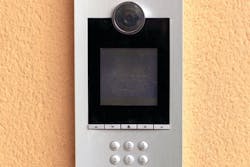Video intercom manufacturers have begun moving toward IP-based systems with higher video quality. Specifically, people want the total situational awareness that an integrated system can provide, according to Steve Gorski, Mobotix general manager.
“People want to make sure they have the ability to integrate not only access control, but video as well,” he said. “They want to know who they’re letting into the building.”
Responding to customer demand, video intercom companies are evolving from analog to IP-based systems. Moving the intercom technology from analog to IP enables users to view visitors via the intercom’s cameras, and then to communicate with them from a remote location. “It expands capabilities to communicate,” said Brad Kamcheff of Aiphone Corp. “Older series of video intercoms have limitations, and IP eliminates that.”
Kamcheff added that IP has been the “absolute buzz-word” in the video intercom space – everyone is using it, from manufacturers, to installers, and end-users. The reason, he said, is that it enables organizations to leverage mobile applications to ensure building security from any location.
Some of the disadvantages of analog systems include high-cost installation, installation complications and distance concerns, Kamcheff concluded. However, Gary Baker, vice president of marketing for intercom provider Linear Corp., said that analog-based systems will continue to be an option based on economic factors. He says the IP-based systems are popular, but not economical. “People don’t want to pay for features they use 10 percent of the time,” he said. “They want it, but at no extra cost, and those types of features cost more.”
With a customer base in the SMB and residential market, it is logical that Baker recommends a more basic video intercom that enables video monitoring without remote two-way communication.
Still, thanks to its many benefits -- including higher resolution and remote access -- Gorski said most manufacturers are moving toward recommending IP-based transitions for their customers. “You’ve seen images [from an analog camera] of a robbery in black-and-white, and you don’t even know if it’s a man or a woman because the image quality is so poor,” he said. “When you have higher resolution, you have the ability to do a lot more with the data and because it’s IP-based and more intelligent."
Along with higher resolution, these systems feature a more flexible, wide-angle view of at least 120 degrees, with PTZ functionality. Due to the flexible viewing capabilities, these systems can be placed at any height on a door station, even though shoulder-height is ideal, Baker said.
“There are no blind spots,” Gorski said. “With traditional systems, you can only see a person’s head and shoulders, and users are unaware of who else or what else is there.” Thus, the ability to pan, tilt and zoom enables users to obtain more information, ultimately making their security stronger. “They’re increasing their security,” Kamcheff said. “They’re able to really see who’s at the door, and they now have internal communication where they couldn’t have it previously.”
Here’s a look at a few newly available intercoms from these manufacturers:
• Mobotix’S T24 IP Video Door Station
• Aiphone’s JK Series
• Linear’s VMC1 Video Intercom System





